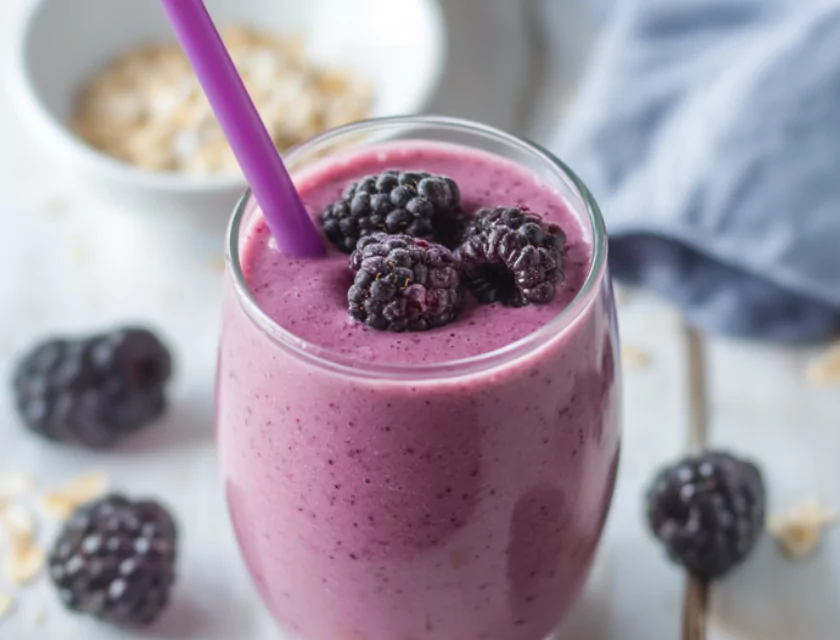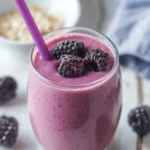Berry smoothies with oatmeal have gained popularity as a nutritious and satisfying meal option. They provide an excellent combination of fiber, protein, healthy fats, and natural sugars, making them an ideal choice for breakfast, post-workout recovery, or a mid-day snack. Oatmeal adds thickness and sustenance, while berries bring antioxidants and vibrant flavors.

Whether you are looking for a quick and easy smoothie recipe, a way to incorporate more whole foods into your diet, or a refreshing summer breakfast option, this berry smoothie with oatmeal is a must-try.
In this article, we’ll explore everything you need to know about this smoothie—from its health benefits and preparation techniques to the best ingredient substitutions and variations.
The Origin and Cultural Significance of Smoothies
Smoothies have been enjoyed for centuries in various cultures. In tropical regions, fruit-based beverages blended with coconut water or yogurt have been a staple. The concept of blending fruits, dairy, and grains gained popularity in the mid-20th century with the advent of modern blenders.
- Oats in Smoothies: Oatmeal has been a dietary staple in many cultures, particularly in Scotland, Northern Europe, and Latin America. The use of oats in drinks is not new—some cultures mix oats with milk and honey for a wholesome breakfast drink.
- Berries in Smoothies: Berries have long been recognized for their nutritional properties. Indigenous groups across North America and Europe have used them for natural healing remedies.
Today, smoothies are widely accepted as a convenient and healthy meal option. Fitness enthusiasts, busy professionals, and parents seeking nutritious alternatives for their children have all embraced the berry smoothie with oatmeal.
Preparation Phase & Tools to Use
Essential Kitchen Tools
To make a smooth, well-blended smoothie, the right tools can make all the difference.
- High-Speed Blender – Helps blend oats and berries to a silky texture without lumps.
- Measuring Cups and Spoons – Ensures the right balance of ingredients.
- Glass or Serving Jars – Ideal for presentation and portability.
- Straw or Spoon – Some prefer drinking smoothies with a straw, while others enjoy a thicker texture with a spoon.
The Importance of Each Tool
- High-Speed Blender: Breaks down oats, ice, and frozen berries efficiently. A weak blender may leave behind a grainy texture.
- Measuring Tools: Helps maintain consistency in flavor and thickness.
- Serving Glass or Jar: If meal-prepping, use a mason jar for easy storage.
- Straw or Spoon: Ideal for different texture preferences—thin smoothies are great for sipping, while thicker ones are better with a spoon.
Preparation Tips for the Best Smoothie
A few key preparation steps will ensure a smooth, creamy, and flavorful smoothie.
- Soak the Oats: Let the oats sit in milk or water for 5-10 minutes before blending for a creamier texture.
- Blend in Stages: Always blend the oats and milk first, then add berries, yogurt, and sweeteners.
- Adjust Thickness: If the smoothie is too thick, add more milk. If too thin, add more oats or yogurt.
- Use Frozen Berries: They enhance the creaminess and eliminate the need for extra ice.
Ingredients List
- ½ cup old-fashioned rolled oats
- 1 cup milk (dairy or plant-based alternatives)
- ½ cup frozen berries (blueberries, raspberries, blackberries, strawberries)
- 3 tablespoons honey (or to taste)
- ⅓ cup vanilla yogurt (or Greek yogurt for extra protein)
- ¼ cup ice
Step-By-Step Instructions
Step 1: Soak the Oats
For a smoother texture, soak the rolled oats in milk for about 5 minutes before blending. This softens them, making them blend more easily.
Step 2: Blend the Base Ingredients
In a high-speed blender, combine the soaked oats and milk. Blend for 10-15 seconds until the oats are fully incorporated.
Step 3: Add the Berries, Yogurt, and Sweetener
- Toss in the frozen berries, honey, and yogurt.
- Blend for another 20-30 seconds until smooth.
Step 4: Add Ice and Final Blend
- Add ¼ cup of ice to make the smoothie thicker and colder.
- Blend until you reach the desired consistency.
Step 5: Adjust and Serve
- Taste the smoothie. If you prefer it sweeter, add an extra ½ tablespoon of honey.
- Pour into a glass or jar and serve immediately.
Customization & Ingredient Variations
Milk Alternatives
- Almond milk – Light and nutty flavor, great for low-calorie options.
- Coconut milk – Adds a tropical twist and extra creaminess.
- Oat milk – Enhances the oat flavor while being dairy-free.
Berry Combinations
- Mixed Berries – Blueberries, raspberries, strawberries, and blackberries.
- Only Blueberries – For a deep, antioxidant-rich smoothie.
- Strawberries & Bananas – A sweeter, kid-friendly version.
Sweetener Substitutes
- Maple Syrup – Great for a richer flavor.
- Agave Nectar – A vegan alternative with a mild taste.
- Stevia or Monk Fruit – Low-carb, keto-friendly options.
Boosting Nutrition
- Chia Seeds – Adds extra fiber and Omega-3s.
- Protein Powder – Enhances muscle recovery and keeps you full longer.
- Nut Butter – Peanut or almond butter for healthy fats and protein.
Best Side Dishes to Pair with a Berry Smoothie with Oatmeal
A berry smoothie with oatmeal is a nutrient-dense and filling option on its own, but pairing it with the right side dishes can enhance its flavor and nutritional benefits. Below are some excellent options to complete your meal.
Greek Yogurt with Granola
A bowl of Greek yogurt topped with granola adds extra protein, probiotics, and crunch. The creaminess of the yogurt complements the smooth texture of the smoothie, while the granola provides a satisfying crunch.
Chia Seed Pudding
This is an excellent high-fiber, high-protein addition to your breakfast. Chia seeds absorb liquid and expand, creating a pudding-like consistency. They are packed with Omega-3s, fiber, and antioxidants, making them a great pairing with a berry smoothie.
Whole Grain Toast with Peanut Butter
The healthy fats and protein in peanut butter help balance the natural sugars in the smoothie. Whole grain toast adds fiber and sustenance, making this combination a well-rounded meal.
Hard-Boiled Eggs
For those who want to increase their protein intake, adding a hard-boiled egg on the side is an easy way to do it. Eggs are rich in vitamins, minerals, and essential amino acids that keep you full longer.
Avocado Toast
Avocados are a great source of healthy fats, fiber, and potassium. Paired with whole grain toast and a sprinkle of sea salt, it provides a savory contrast to the naturally sweet smoothie.
Almond Butter Rice Cakes
For a lighter option, rice cakes topped with almond butter offer a great balance of carbs, protein, and healthy fats. The crunchy texture contrasts nicely with the smoothness of the berry smoothie.
Fruit Salad with Nuts
A fresh fruit salad with almonds, walnuts, or cashews adds a mix of vitamins, minerals, and healthy fats. Berries, apples, bananas, and citrus fruits complement the flavors in the smoothie.
Cottage Cheese with Honey and Nuts
Cottage cheese is an excellent source of protein and pairs well with a drizzle of honey and a handful of nuts. This side dish adds texture and richness to your meal.
Nutritional Information & Health Benefits of a Berry Smoothie with Oatmeal
A berry smoothie with oatmeal is packed with essential nutrients. Below is a breakdown of the key nutritional benefits.
High in Fiber
- Oats and berries provide soluble and insoluble fiber, which aids digestion and helps maintain healthy cholesterol levels.
- Fiber promotes satiety, keeping you full longer and reducing unnecessary snacking.
Rich in Antioxidants
- Berries are loaded with antioxidants, such as anthocyanins and flavonoids, which help protect the body from oxidative stress and inflammation.
- Antioxidants support brain health, improve heart function, and boost immunity.
Good Source of Protein
- Greek yogurt and milk add high-quality protein, essential for muscle recovery and overall health.
- Oats contain plant-based protein, making this smoothie a well-rounded choice.
Supports Heart Health
- Oats contain beta-glucan, a type of soluble fiber that helps reduce cholesterol levels and improve heart function.
- The potassium in berries and yogurt contributes to maintaining healthy blood pressure.
Boosts Energy Levels
- The complex carbohydrates in oats provide long-lasting energy, preventing blood sugar spikes and crashes.
- The natural sugars in fruit offer a quick energy boost, while healthy fats from dairy or plant-based milk provide sustained energy.
Promotes Gut Health
- Yogurt contains probiotics, which support gut microbiota and improve digestion.
- Fiber from oats and berries promotes a healthy digestive system.
Great for Weight Management
- High-fiber, high-protein meals help regulate appetite and prevent overeating.
- The nutrient-dense composition ensures you stay full while maintaining a balanced calorie intake.
Common Mistakes to Avoid & How to Perfect the Recipe
Even with a simple recipe, small mistakes can affect the taste, texture, and nutritional value of the smoothie. Here are the most common errors and how to avoid them.
Using Quick Oats Instead of Rolled Oats
Quick oats are more processed and tend to turn mushy when blended, while rolled oats provide better texture and nutrition. Always choose old-fashioned rolled oats for the best results.
Skipping the Soaking Step
Blending dry oats directly into the smoothie can result in a gritty texture. Soaking them in milk or water for at least 5 minutes before blending will help create a smoother consistency.
Adding Too Much Liquid
A thin and watery smoothie usually results from too much liquid. If this happens, balance it out by adding more oats, frozen fruit, or yogurt to thicken the consistency.
Not Blending Long Enough
Under-blending can leave small chunks of oats and berries, making the smoothie grainy or uneven. Blend for at least 30-45 seconds to achieve a smooth and creamy texture.
Using a Low-Powered Blender
A weak blender may not properly break down oats, ice, and frozen berries, leading to lumps and an uneven texture. A high-speed blender ensures a silky smooth finish.
Forgetting to Sweeten (or Over-Sweetening)
- Berries can sometimes be tart, so a small amount of honey, maple syrup, or agave can enhance the flavor.
- Avoid adding too much sweetener, as it can overpower the natural taste of the ingredients.
Skipping Ice or Frozen Fruit
Ice or frozen fruit helps create a cold, refreshing smoothie. Without it, the smoothie may feel lukewarm or too thick. If you don’t want to add ice, use frozen berries instead.
Not Experimenting with Flavors
Many people stick to the same recipe every time, but smoothies are highly customizable. Try adding:
- Nut butters (almond, peanut, cashew) for extra creaminess and protein.
- Seeds (chia, flax, hemp) for additional fiber and Omega-3s.
- Spices (cinnamon, nutmeg, vanilla extract) for a flavor boost.
Using Artificial Ingredients
Some people add flavored yogurt, sugary protein powders, or sweetened milk alternatives that contain added sugars and preservatives. Stick to natural, whole ingredients to keep the smoothie healthy and nutritious.



Leave a Comment